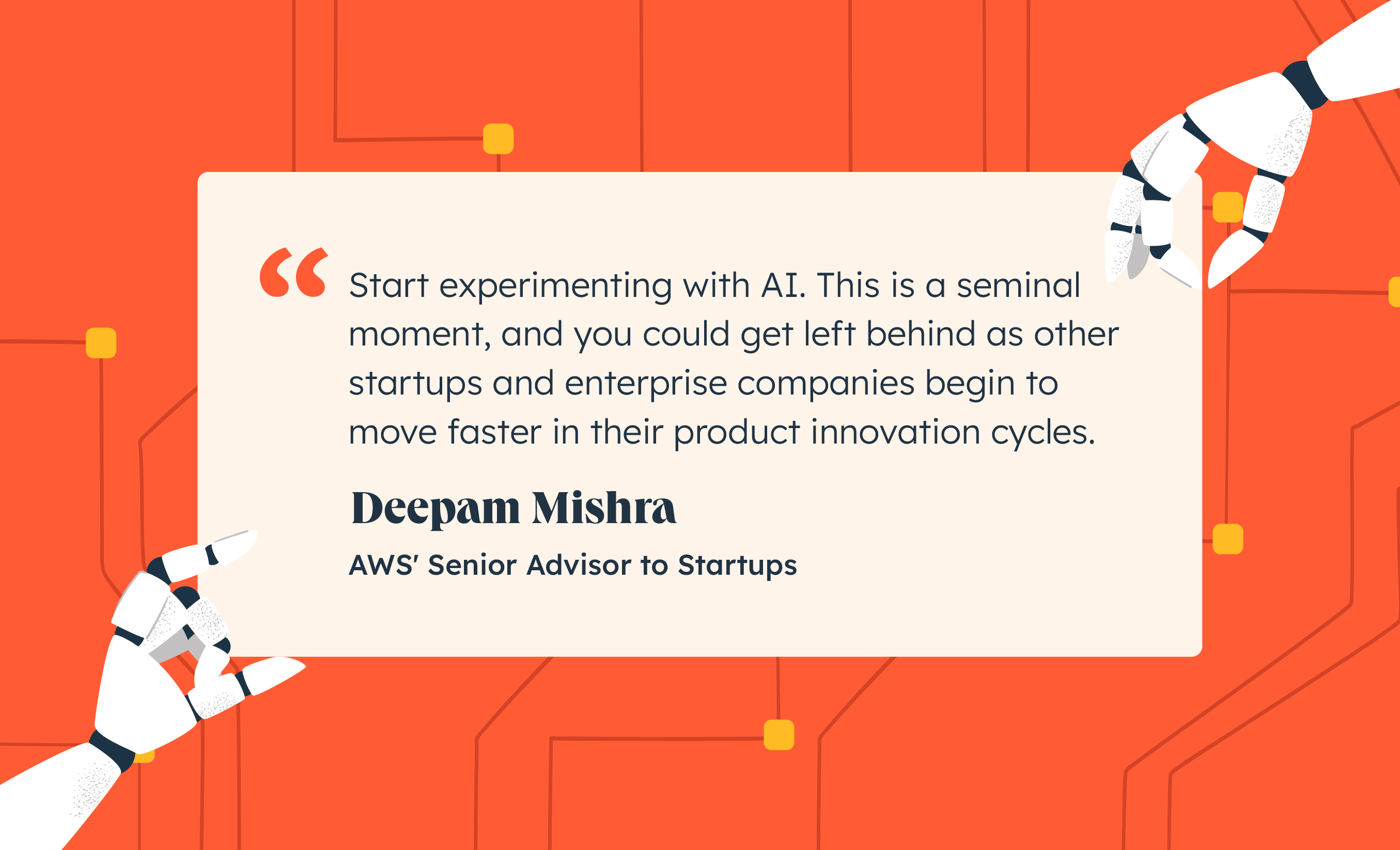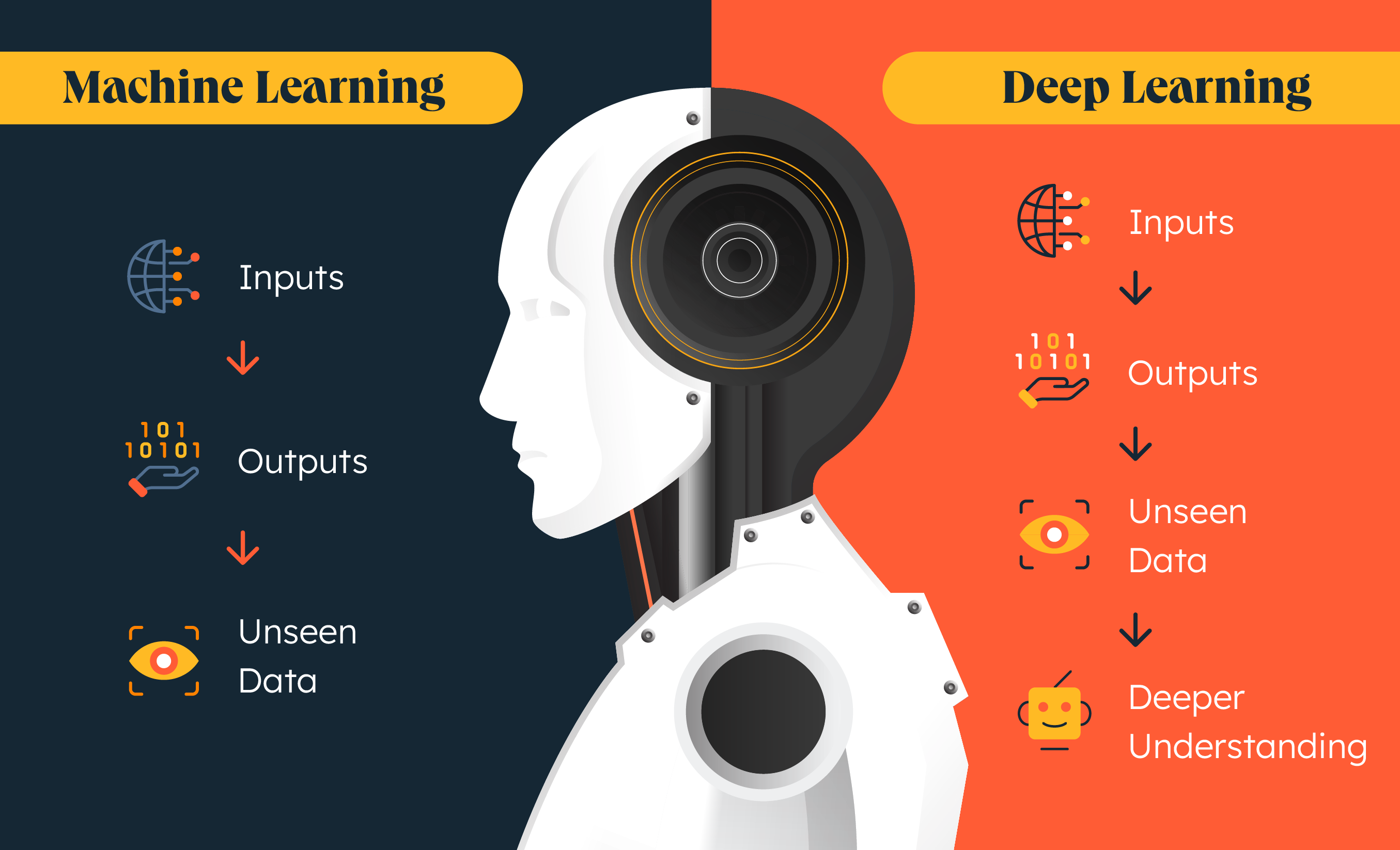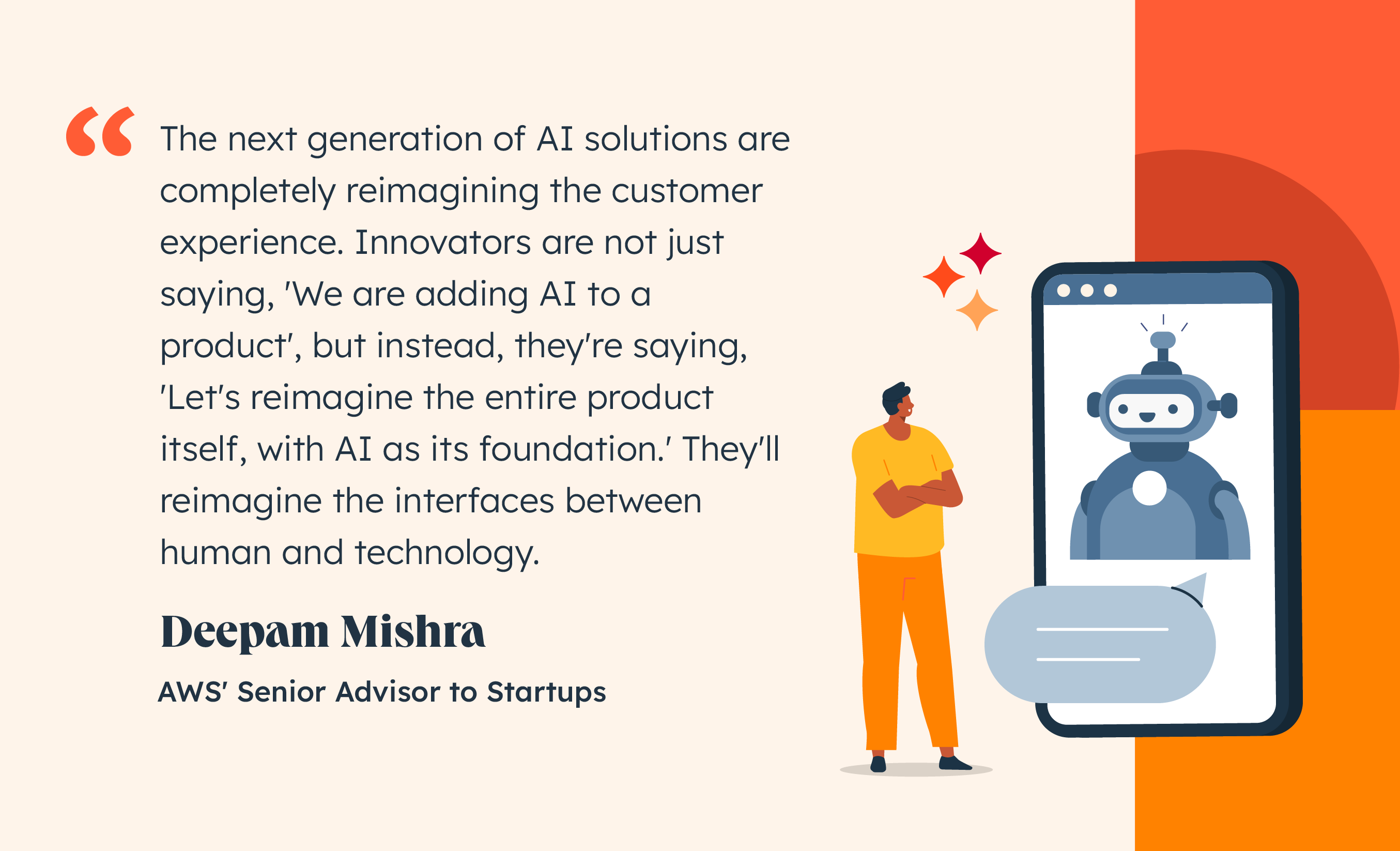As any business owner knows, product-market fit is one of the most challenging aspects of starting a business.
Predicting the right product to build – and investing in building prototypes, experimenting, and testing — is an exhaustingly long and expensive process, and oftentimes, business owners run out of money before they’re even able to test their products.
Fortunately, as AWS Senior Advisor to Startups and AI expert Deepam Mishra told me, “This process is about to be turned on its head with the newest advances in AI.”
I sat down with Mishra to discuss how AI will revolutionize every aspect of the product development process, and how startups and SMBs should prepare for it.
How AI Will Revolutionize Product Development, According to AWS’ Senior Advisor to Startups
1. Product-market fit predictions will be more accurate.
From Mishra’s experience, he’s seen many startups fail due to poor product-market fit.
This corresponds with wider trends. A whopping 35% of SMBs and startups fail due to no market need.
Fortunately, AI can help solve for this. AI-fueled data analysis can help startups collect a more accurate, well-rounded view of the quantitative and qualitative data they‘ll need to determine whether their product actually meets their customers’ needs — or whether they’ve even selected the right audience in the first place.
Leveraging AI when collecting and analyzing data can also help teams understand their customers on a deeper level.
As Mishra told me, “AI can make it easier to understand the real customer needs hiding behind known problems. Often engineers start building prototypes without a deep understanding of the quantitative and qualitative customer needs. Before generative AI there were less capable tools to analyze such information.”
2. AI will greatly enhance speed of iteration and time to market.
Creating mockups and prototypes of a product you want to test is one of the most time-consuming aspects of the product development lifecycle. It typically takes four to 12 weeks to create an electronics prototype, and one to four weeks for a 3D printed mockup.
“The time it takes to generate a physical incarnation — or even a 3D or visual incarnation of a product — requires some real physics behind it,” Mishra explains.
“It’s a fairly long process for product managers, designers, and software engineers to build a product into a three-dimensional model.”
In other words: All that time and money you put into creating and testing a prototype could end up costing you your business.
Imagine the power, then, of a world in which AI can help you create mockups and prototypes in just a few hours.
This speed is more than just convenient: It could be life-saving for SMBs and startups that don‘t have the time or resources to waste on product features that won’t yield strong returns.
For Mishra, it’s one of the most exciting areas of opportunity in the product space.
As he puts it, “The fact that you can create content from scratch with such rapid speed, and hit a higher level of accuracy, is one of the most exciting components of all this.”

3. AI will change how you collect customer feedback.
Once you have a prototype, or even a minimum viable product, you can‘t stop iterating there. You’ll need to test it with prospective or current customers to learn how to improve or iterate upon it next.
And, until now, product analytics has been largely restricted to structured or numerical data.
But structured data has its limitations.
Mishra told me, “Most enterprise information is unstructured, as it sits in the forms of documents and emails and social media chatter. I would guess that less than 20% of a business’ data is structured data. So there’s a huge opportunity cost in not analyzing that 70% to 80% of information.”
In other words, there aren’t many scalable solutions to collecting and analyzing quantitative data to analyze how customers are responding to your product.
For now, many product teams rely on focus groups to collect feedback, but focus groups aren’t always accurate representations of customer sentiment, which leaves your product team vulnerable to potentially creating a product that doesn’t actually serve your customers.
Fortunately, “Generative AI can help convert customer feedback into data for your business,” Mishra explains. “Let’s say you get a lot of social media feedback or product usage comments or chatter on customer forums. Now, you can convert that information into charts and trend lines and analyze it in the same way you’ve always analyzed structured data.”
He adds, “Essentially, you can figure out which features your customers are talking about the most. Or, what emotions customers have when it comes to particular product features. This helps you determine product-market fit, or even which features to add or remove from your product.”
The potential impact of being able to convert quantitative feedback into actionable data points is enormous.
With the help of AI, your team can feel more confident that you’re truly investing time and energy into product features that matter most to your customers.
4. AI will redefine how engineers and product managers interact with software.
Beyond developing a product, AI can also innovate the teams developing it.
Up until now, we‘ve had entire roles defined around getting people trained on a particular product suite. They’ve become the experts on a given software, and understand how each piece works.
In the future, we’ll begin to see how AI can help your team ramp up new employees without necessarily needing these software experts to host trainings.
Perhaps you have a junior programmer on your team with limited experience. To ensure she adheres to your company’s particular discipline of software coding, you can have a lot of it pre-programmed and systematized through AI code generation tools.
For more intensive processes, like prototyping, Mishra explains that some training duties could even be replaced by chat-based AI. “We have moved to realizing that more natural chat-type interfaces can substitute very complex ways of asking for help from software and hardware tools.”
Let’s say your company needs to design a widget. Rather than spending time and resources on mocking up a prototype, you could ask a chatbot to produce some design examples and provide constraints.
“You don’t need to even know what machine learning tools are being used,” Mishra adds, “you just talk to a chat interface, and maybe there are five different products behind the chat. But as humans, we care less about the tool and more about the outputs.”
5. AI will lift human creativity in the product space.
Machine learning has been around for almost two decades, and has already been leveraged for a long time in the product development space.
But it’s about to change drastically.
As Mishra explained to me, the old machine learning algorithms could learn patterns of transforming inputs to outputs, and could then apply that pattern to unseen data.
But the new generative machine models take this process a step further: They can still apply patterns to unseen data, but they can also get a deeper understanding of the thinking behind the creative process.

“They can understand how a software programmer creates software, or how a designer creates a design, or how an artist creates art,” Mishra told me.
He adds, “These models are beginning to understand the thinking behind the creation, which is both an exciting and scary part of it. But where this applies to pretty much all stages of product development is that you can now supercharge the human creativity component.”
In other words: AI will become any product manager, engineer, or designer’s co-pilot as they navigate a new terrain, in which rote, repeatable actions will be replaced by time spent designing and iterating on better, more powerful products.
Eventually, AI Will Change the Customer Experience Entirely
There’s a separate, deeper conversation to be had about the long-term ramifications of AI and the product space.
For now, product leadership has largely focused on how they can effectively enhance their products by adding AI into their existing features.
As Mishra puts it, “Most leaders right now are saying, ‘Let me swap what I had with generative AI.’ So you might think of these products as version 2.0 of a previous model.”
“But,” he continues,“the next generation of solutions, which some of the more ambitious innovators are starting to work on, are completely reimagining the customer experience. They’re not just saying, ‘We are adding AI to a product,’ but instead, they’re saying, ‘Let’s reimagine the entire product itself, with AI as its foundation.’ They’ll reimagine the interfaces between human and technology.”

Right now, consumers choose between a variety of streaming services, such as Netflix or Amazon Prime, and then the streaming service provides AI-based recommendations based on prior user behavior.
As Mishra explains, “The first wave of startups will say, ‘Okay, let’s make those predictions better.’ But the second wave of startups or innovators will say, ‘Wait a second … Why do you even need to be worried about just one platform? Why not think bigger?’”
“So we’ll have companies that say, ‘Let me generate content on various platforms depending on your mood and 10,000 other behaviors, versus the three genres I know you like.”
How does this fit into the current product development process? It doesn’t.
Instead, it flips it entirely upside down. And that’s both terrifying and thrilling.
Mishra suggests, “How do you reimagine the product experience? I think that’s where human creativity is going to be applied.”
How to Get Started with AI and Product Development
1. Start experimenting.
Mishra acknowledges that as much as it‘s an exciting time in the product space, it’s also a challenging time, and plenty of SMBs and startups are questioning whether they should even invest in AI at all.
Change is happening quickly, and it can be difficult to determine which aspects of AI you should invest in, or how you should approach implementing it into your current processes.
Mishra‘s advice? “Start experimenting, because you’ll find it a lot easier once you get started. And there are a couple of areas which will give you value regardless of whether you put AI into production or not, including analyzing customer information and feedback, or doing things like enterprise search — you’ll start to see eye-opening value from these experiments, which will guide you down the right path.”
Fortunately, you don‘t need to hire your own machine learning engineer to create something from scratch. Instead, you might consider tools like Amazon’s recently released Bedrock, which provides pre-built generative AI models that you can add to an existing application with an API. This enables you to forgo any AI training and limit the data breach risks, and be up and running in minutes.
2. Identify where AI can help your team.
Mishra recommends figuring out the right use cases that will have a positive ROI for your business.
Ultimately, it’s critical you take the time to determine which areas of the business could get the highest value from AI, and start there.
For instance, he suggests, “I’m seeing a lot of work in the areas of customer-facing activities because that drives revenue, so that’s potentially high-value.”
If you‘re unsure where to get started on your own team, there’s no need to reinvent the wheel. Consider reaching out to cloud experts or startups that can walk you through some common solutions already being explored by other companies.
3. Get stakeholder buy-in.
There’s another equally-vital requirement to experimentation: Stakeholder and leadership buy-in.
Mishra says, “I think cultural alignment and stakeholder alignment is an important area that companies need to start working on. If the top leadership is fearful for the wrong reasons, that could inhibit their growth.”
There are certainly privacy and data leakage concerns when it comes to AI. Plus, AI isn‘t perfect: It can hallucinate or provide inaccurate or biased information when it’s providing results.
Which means, when convincing leadership to invest in AI, it‘s critical that you emphasize that AI will not be steering the ship. Instead, it will be your team’s trusted co-pilot.
It‘s also important to note — if leadership feels it’s risky to invest in AI, they should also be considering the risks of not investing in it.
As Mishra puts it, “This is a seminal moment, and you can get left behind as other startups and enterprise companies begin to move faster in their product innovation cycles.”
![]()


